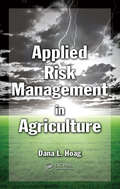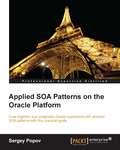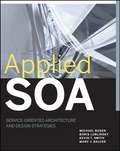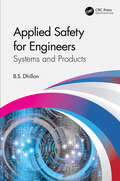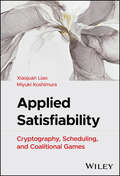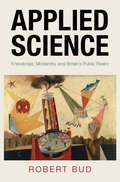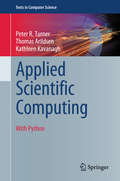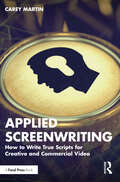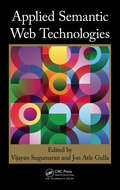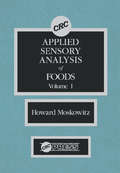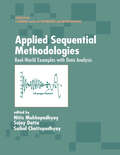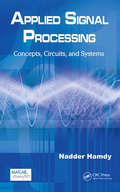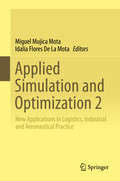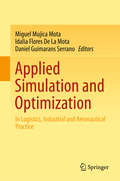- Table View
- List View
Applied Research on Policing for Police: The case of Cyprus (SpringerBriefs in Criminology)
by Angelo G. ConstantinouThis brief discusses a series of empirical studies on policing in Cyprus, applying research to practice. It discusses police culture and tactics, and addresses politicized policing. Using primary data based on both quantitative and qualitative studies on the day-to-day issues of front-line policing in Cyprus, this volume will be of interest to academics, researchers and practitioners interested in comparative international policing, evidence-based policing, and contextualization of policing in Cyprus.
Applied Respiratory Pathophysiology
by Louis-Philippe BouletThis easy yet comprehensive reference guide covers the mechanisms of respiratory diseases, explaining the main respiratory conditions for clinicians and postgraduate trainees. It discusses their aetiology as well as the basic concepts required to effectively evaluate and treat them. Applied Respiratory Pathophysiology is the first book to bring together detailed, clinically-relevant explanation of respiratory physiological processes and pathophysiological processes in one text. It is essential reading for anyone diagnosing and treating specific clinical conditions of the lungs.
Applied Risk Analysis for Guiding Homeland Security Policy and Decisions (Wiley Series in Operations Research and Management Science)
by Samrat Chatterjee Robert T. Brigantic Angela M. WaterworthPresents various challenges faced by security policy makers and risk analysts, and mathematical approaches that inform homeland security policy development and decision support Compiled by a group of highly qualified editors, this book provides a clear connection between risk science and homeland security policy making and includes top-notch contributions that uniquely highlight the role of risk analysis for informing homeland security policy decisions. Featuring discussions on various challenges faced in homeland security risk analysis, the book seamlessly divides the subject of risk analysis for homeland security into manageable chapters, which are organized by the concept of risk-informed decisions, methodology for applying risk analysis, and relevant examples and case studies. Applied Risk Analysis for Guiding Homeland Security Policy and Decisions offers an enlightening overview of risk analysis methods for homeland security. For instance, it presents readers with an exploration of radiological and nuclear risk assessment, along with analysis of uncertainties in radiological and nuclear pathways. It covers the advances in risk analysis for border security, as well as for cyber security. Other topics covered include: strengthening points of entry; systems modeling for rapid containment and casualty mitigation; and disaster preparedness and critical infrastructure resilience. Highlights how risk analysis helps in the decision-making process for homeland security policy Presents specific examples that detail how various risk analysis methods provide decision support for homeland security policy makers and risk analysts Describes numerous case studies from academic, government, and industrial perspectives that apply risk analysis methods for addressing challenges within the U.S. Department of Homeland Security (DHS) Offers detailed information regarding each of the five DHS missions: prevent terrorism and enhance security; secure and manage our borders; enforce and administer our immigration laws; safeguard and secure cyberspace; and strengthen national preparedness and resilience Discusses the various approaches and challenges faced in homeland risk analysis and identifies improvements and methodological advances that influenced DHS to adopt an increasingly risk-informed basis for decision-making Written by top educators and professionals who clearly illustrate the link between risk science and homeland security policy making Applied Risk Analysis for Guiding Homeland Security Policy and Decisions is an excellent textbook and/or supplement for upper-undergraduate and graduate-level courses related to homeland security risk analysis. It will also be an extremely beneficial resource and reference for homeland security policy analysts, risk analysts, and policymakers from private and public sectors, as well as researchers, academics, and practitioners who utilize security risk analysis methods.
Applied Risk Management in Agriculture
by Dana L. HoagDefining the fundamentals of building a risk management plan, Applied Risk Management in Agriculture uses strategic management to organize the process of risk management. A time-tested procedure inside and outside the business community, this technique provides an ideal platform for organizing risk.Making complex principles easily accessible to stu
Applied SOA Patterns on the Oracle Platform
by Sergey PopovApplied SOA Patterns on the Oracle Platform is aimed at architects practicing SOA or traditional integration, and also at technical team leaders implementing Oracle Fusion under SCRUM or WF methodology.
Applied SOA: Service-Oriented Architecture and Design Strategies
by Mike Rosen Boris Lublinsky Kevin T. Smith Marc J. BalcerEndorsed by all major vendors (Microsoft, Oracle, IBM, and SAP), SOA has quickly become the industry standard for building next-generation software; this practical guide shows readers how to achieve the many benefits of SOA Begins with a look at the architectural principles needed to create successful applications and then goes on to examine the process for designing services and SOA implementations Each stage of the design process has an accompanying chapter that walks readers through the details and provides helpful tips, techniques, and examples The author team of SOA practitioners also provides two unique, comprehensive, end-to-end case studies illustrating the architectural and design techniques presented in the book
Applied Safety for Engineers: Systems and Products
by B.S. DhillonGlobal competition and other factors are forcing manufacturers to produce highly safe engineering systems and products. This book meets the needs for product designers, systems engineers, and safety engineers that work together and need a single resource which considers all three areas when designing new products and systems that they can refer to. Applied Safety for Engineers: Systems and Products serves as a comprehensive resource offering a wide range of safety topics when involved with product design, engineering system analysis, and engineering maintenance. Examples along with their solutions are placed at the end of each chapter to test reader comprehension. The book facilitates the importance for product designers, safety, and systems engineering professionals to work closely during the product design phase so they can understand each other’s discipline. Written in a manner that readers do not need any previous knowledge on the subject, the book offers many sources for further reading at the end of each chapter. This book will be useful to product designers, system engineers, safety specialists, graduate and senior undergraduate students, researchers and manufacturers, industrial engineers, safety engineers, and engineers-at-large.
Applied Satisfiability: Cryptography, Scheduling, and Coalitional Games
by Xiaojuan Liao Miyuki KoshimuraApply satisfiability to a range of difficult problems The Boolean Satisfiability Problem (SAT) is one of the most famous and widely-studied problems in Boolean logic. Optimization versions of this problem include the Maximum Satisfiability Problem (MaxSAT) and its extensions, such as partial MaxSAT and weighted MaxSAT, which assess whether, and to what extent, a solution satisfies a given set of problems. Numerous applications of SAT and MaxSAT have emerged in fields related to logic and computing technology. Applied Satisfiability: Cryptography, Scheduling, and Coalitional Games outlines some of these applications in three specific fields. It offers a huge range of SAT applications and their possible impacts, allowing readers to tackle previously challenging optimization problems with a new selection of tools. Professionals and researchers in this field will find the scope of their computational solutions to otherwise intractable problems vastly increased. Applied Satisfiability readers will also find: Coding and problem-solving skills applicable to a variety of fieldsSpecific experiments and case studies that demonstrate the effectiveness of satisfiability-aided methodsChapters covering topics including cryptographic key recovery, various forms of scheduling, coalition structure generation, and many more Applied Satisfiability is ideal for researchers, graduate students, and practitioners in these fields looking to bring a new skillset to bear in their studies and careers.
Applied Science: Knowledge, Modernity, and Britain's Public Realm (Science in History)
by Robert BudFor almost two centuries, the category of 'applied science' was widely taken to be both real and important. Then, its use faded. How could an entire category of science appear and disappear? By taking a longue durée approach to British attitudes across the nineteenth and twentieth centuries, Robert Bud explores the scientific and cultural trends that led to such a dramatic rise and fall. He traces the prospects and consequences that gave the term meaning, from its origins to its heyday as an elixir to cure many of the economic, cultural, and political ills of the UK, eventually overtaken by its competitor, 'technology'. Bud examines how 'applied science' was shaped by educational and research institutions, sociotechnical imaginaries, and political ideologies and explores the extent to which non-scientific lay opinion, mediated by politicians and newspapers, could become a driver in the classification of science.
Applied Sciences in Graphic Communication and Packaging: Proceedings of 2017 49th Conference of the International Circle of Educational Institutes for Graphic Arts Technology and Management & 8th China Academic Conference on Printing and Packaging (Lecture Notes in Electrical Engineering #477)
by Min Xu Li Yang Yun Ouyang Pengfei Zhao Yuhui RenThis book includes a selection of reviewed papers presented at the 49th Conference of the International Circle of Educational Institutes for Graphic Arts Technology and Management & 8th China Academic Conference on Printing and Packaging, which was held on May 14-16, 2017 in Beijing, China. The conference was jointly organized by the Beijing Institute of Graphic Communication, China Academy of Printing Technology, and International Circle of Educational Institutes for Graphic Arts Technology and Management. With eight keynote talks and 200 presented papers on graphic communication and packaging technologies, the event attracted more than 400 scientists. The proceedings cover the latest advances in color science and technology; image processing technology; digital media technology; digital process management technology in packaging; packaging, etc. , and will be of interest to university researchers, R&D engineers and graduate students in the graphic arts, packaging, color science, image science, material science, computer science, digital media and network technology.
Applied Scientific Computing: With Python (Texts in Computer Science)
by Peter R. Turner Thomas Arildsen Kathleen KavanaghThis easy-to-understand textbook presents a modern approach to learning numerical methods (or scientific computing), with a unique focus on the modeling and applications of the mathematical content. Emphasis is placed on the need for, and methods of, scientific computing for a range of different types of problems, supplying the evidence and justification to motivate the reader. Practical guidance on coding the methods is also provided, through simple-to-follow examples using Python.Topics and features: provides an accessible and applications-oriented approach, supported by working Python code for many of the methods; encourages both problem- and project-based learning through extensive examples, exercises, and projects drawn from practical applications; introduces the main concepts in modeling, python programming, number representation, and errors; explains the essential details of numerical calculus, linear, and nonlinear equations, including the multivariable Newton method; discusses interpolation and the numerical solution of differential equations, covering polynomial interpolation, splines, and the Euler, Runge–Kutta, and shooting methods; presents largely self-contained chapters, arranged in a logical order suitable for an introductory course on scientific computing.Undergraduate students embarking on a first course on numerical methods or scientific computing will find this textbook to be an invaluable guide to the field, and to the application of these methods across such varied disciplines as computer science, engineering, mathematics, economics, the physical sciences, and social science.
Applied Screenwriting: How to Write True Scripts for Creative and Commercial Video
by Carey MartinPutting a vision on the page for creative and commercial video is harder than it seems, but author Carey Martin explains how to bring these tools to bear in the “work for hire” environment. Whilst other texts focus on writing the next award winner, this can be out of reach both logistically and financially for many. Instead, readers will learn how to write what they want the eyes of the audience to see and the ears of the audience to hear, in such a way that the Producer and Director can read the creative blueprint and bring that vision to life. The text will walk readers through a focused and practical consideration of the camera, the edit, and the sound design, in addition to a straightforward application of basic story principles. By understanding writing for video as more than creating a recorded play, readers will become more effective screenwriters and, should they wish, Producers and Directors as well. This book is ideal for students of screenwriting and those writing scripts for message-driven video for corporate, nonprofit, and commercial production.
Applied Second Law Analysis of Heat Engine Cycles
by S. Can GülenApplied Second Law Analysis of Heat Engine Cycles offers a concise, practical approach to one of the two building blocks of classical thermodynamics and demonstrates how it can be a powerful tool in the analysis of heat engine cycles. Including real system models with the industry-standard heat balance simulation software, the Thermoflow Suite (GTPRO/MASTER, PEACE, THERMOFLEX) and Excel VBA, the book discusses both the performance and the cost. It also features both calculated and actual examples for gas turbines, steam turbines, and simple and combined cycles from major original equipment manufacturers (OEMs). In addition, novel cycles proposed by researchers and independent technology developers will also be critically examined. This book will be a valuable reference for practicing engineers, enabling the reader to approach the most difficult thermal design and analysis problems in a logical manner.
Applied Seismic Geostructures: Characterizing Fault Damage Zones Quantitatively
by Zonghu LiaoThis book focuses on the characterization of fault damage zones and subsurface structure systems quantitatively for the first time. It provides a comprehensive case study of various types of fault damage zones, including normal, reverse, strike-slip, and composite zones. The book also explores fractures within fault damage zones and the effect of faulting on cap rock integrity. Through meticulous case studies and analyses from diverse geographical regions, this book elucidates the seismic characteristics and behaviors associated with fault damage zones. Readers will find particular interest in the methods and results presented in the book, as it offers a holistic and systematic approach to understanding and building seismic geostructures. Incorporating seismic attributes and coherence analysis, as well as applying neural networks, it provides readers with innovative techniques in fault characterization and segmentation. Besides, this book incorporates illustrative visuals, insightful tables, and cutting-edge seismic attributes, which enhance the reader's understanding of the subject matter. Researchers, professionals, and students in petroleum geology, geophysics, and engineering will find this book to be an invaluable resource with the practical insights and innovative methodologies it offers for the state-of-the-art characterizing and analyzing fault damage zones.
Applied Semantic Web Technologies
by Vijayan Sugumaran Jon Atle GullaThe rapid advancement of semantic web technologies, along with the fact that they are at various levels of maturity, has left many practitioners confused about the current state of these technologies. Focusing on the most mature technologies, Applied Semantic Web Technologies integrates theory with case studies to illustrate the history, current st
Applied Sensory Analy of Foods
by Howard R. MoskowitzThis book extends the analysis of perception of food qualities to the area of multivariate methods. It presents the field of sensory analysis and gives the reader first-hand descriptions of research approaches and applications.
Applied Sequential Methodologies: Real-World Examples with Data Analysis
by Hitis Mukhopadhyay Suiay Datta Saibal ChattopadhyayA technically precise yet clear presentation of modern sequential methodologies having immediate applications to practical problems in the real world, Applied Sequential Methodologies communicates invaluable techniques for data mining, agricultural science, genetics, computer simulation, finance, clinical trials, sonar signal detection, randomizati
Applied Shakespeare: A Transformative Encounter?
by Adelle HulsmeierThis book speaks to those interested in where and why Shakespeare’s work is used to capture the transformative intentions of different areas of Applied Theatre practice (Prison, Disability, Therapy), representing a foundational study which considers subsequent histories and potential challenges when engaging with Shakespeare’s work. This is grounded in a case study analysis of three salient British Theatre Companies: The Education Shakespeare Company (prison), the Blue Apple Theatre Company (Disability), and the Combat Veteran Players (therapy).
Applied Signal Processing: Concepts, Circuits, and Systems
by Nadder HamdyClassical signal processing techniques are based primarily on the analog nature of all signals. However, the continuously improving performance of digital circuitry and processors has prompted a switch to digital signal processing techniques rather than the traditional analog ones.Applied Signal Processing recognizes the linkage between
Applied Simulation and Optimization 2: New Applications in Logistics, Industrial and Aeronautical Practice
by Miguel Mujica Mota Idalia Flores De La MotaBuilding on the author's earlier Applied Simulation and Optimization, this book presents novel methods for solving problems in industry, based on hybrid simulation-optimization approaches that combine the advantages of both paradigms. The book serves as a comprehensive guide to tackling scheduling, routing problems, resource allocations and other issues in industrial environments, the service industry, production processes, or supply chains and aviation. Logistics, manufacturing and operational problems can either be modelled using optimization techniques or approaches based on simulation methodologies. Optimization techniques have the advantage of performing efficiently when the problems are properly defined, but they are often developed through rigid representations that do not include or accurately represent the stochasticity inherent in real systems. Furthermore, important information is lost during the abstraction process to fit each problem into the optimization technique. On the other hand, simulation approaches possess high description levels, but the optimization is generally performed through sampling of all the possible configurations of the system. The methods explored in this book are of use to researchers and practising engineers in fields ranging from supply chains to the aviation industry.
Applied Simulation and Optimization: In Logistics, Industrial and Aeronautical Practice
by Miguel Mujica Mota Idalia Flores De La Mota Daniel Guimarans SerranoPresenting techniques, case-studies and methodologies that combine the use of simulation approaches with optimization techniques for facing problems in manufacturing, logistics, or aeronautical problems, this book provides solutions to common industrial problems in several fields, which range from manufacturing to aviation problems, where the common denominator is the combination of simulation's flexibility with optimization techniques' robustness. Providing readers with a comprehensive guide to tackle similar issues in industrial environments, this text explores novel ways to face industrial problems through hybrid approaches (simulation-optimization) that benefit from the advantages of both paradigms, in order to give solutions to important problems in service industry, production processes, or supply chains, such as scheduling, routing problems and resource allocations, among others.
Applied Smart Health Care Informatics: A Computational Intelligence Perspective (The Wiley Series in Intelligent Signal and Data Processing)
by Sourav DeApplied Smart Health Care Informatics Explores how intelligent systems offer new opportunities for optimizing the acquisition, storage, retrieval, and use of information in healthcare Applied Smart Health Care Informatics explores how health information technology and intelligent systems can be integrated and deployed to enhance healthcare management. Edited and authored by leading experts in the field, this timely volume introduces modern approaches for managing existing data in the healthcare sector by utilizing artificial intelligence (AI), meta-heuristic algorithms, deep learning, the Internet of Things (IoT), and other smart technologies. Detailed chapters review advances in areas including machine learning, computer vision, and soft computing techniques, and discuss various applications of healthcare management systems such as medical imaging, electronic medical records (EMR), and drug development assistance. Throughout the text, the authors propose new research directions and highlight the smart technologies that are central to establishing proactive health management, supporting enhanced coordination of care, and improving the overall quality of healthcare services. Provides an overview of different deep learning applications for intelligent healthcare informatics management Describes novel methodologies and emerging trends in artificial intelligence and computational intelligence and their relevance to health information engineering and management Proposes IoT solutions that disseminate essential medical information for intelligent healthcare management Discusses mobile-based healthcare management, content-based image retrieval, and computer-aided diagnosis using machine and deep learning techniques Examines the use of exploratory data analysis in intelligent healthcare informatics systems Applied Smart Health Care Informatics: A Computational Intelligence Perspective is an invaluable text for graduate students, postdoctoral researchers, academic lecturers, and industry professionals working in the area of healthcare and intelligent soft computing.
Applied Social Marketing and Quality of Life: Case Studies from an International Perspective (Applying Quality of Life Research)
by M. Mercedes Galan-Ladero Reynaldo G. RiveraThis book discusses how various social marketing campaigns have taken up and had an impact on important aspects of quality of life across the world. The chapters bring up case studies from different regions, showing how successful social marketing campaigns have been instrumental in addressing public health challenges, discrimination and exclusion, violence, and inequity; and in changing public perceptions in different countries and through public and nonprofit organizations, but also through businesses. Thus, this book approaches social marketing from a quality-of-life (QOL) marketing philosophy, taking an international perspective. It includes 26 case studies discussing how social marketing campaigns were developed and implemented in specific cases related to disease prevention and risk behavior, safe and healthy lifestyles, and inclusion and interpersonal relationships. It also covers social marketing campaigns related to COVID-19 in various countries. The book is both comprehensive and provides in-depth understanding of every case, and is useful for research, policy making, development communication and social marketing. Graduate students, researchers, practitioners, and social marketers alike will find this book interesting.
Applied Social Psychology
by Linda Steg Talib Rothengatter Kees Keizer Buunk Abraham P.`I think this is a wonderful book. The social psychological theories are exceptionally well presented for practical use. Anyone studying social psychology will find this book extremely relevant and accessible' - Gerjo Kok, Professor of Applied Psychology, Department of Work and Social Psychology, Maastricht University `This is a highly readable book dealing with an exciting topic, applied social psychology, which is at the heart of many urgent problems of the new millennium. It is well suited for curing the disease of those who still believe there is an opposition between fundamental and applied research, between theories and practice. The major asset of this volume lies in the originality and strength of the PATH concept -- from problem definition, over analysis, and test, to helping. I like the idea to implement and institutionalize this framework in teaching and in education' - Klaus Fiedler, University of Heidelberg Introducing a new methodological approach for doing applied psychology, the PATH model, this book offers a simple, systematic, step-by-step, easy-to-use methodology for applying primarily social psychological theory to a wide range of social problems, from tackling crime and prejudice to fostering environmental conservation and team performance. It helps and guides students to define a problem, conduct a theory-based analysis, develop an explanatory model, set up and execute a research project to test the model, and develop an intervention. Applying Social Psychology is a highly practical text, which can be used by introductory and advanced level students who want to learn how to analyze practical problems and develop solutions for these problems based upon social psychological theory and research. Written in an engaging and accessible way, this book offers: 1. A new methodological model put forward by the authors (PATH model); 2. Real world case studies; 3. End of chapter exercises; 4. Interviews with leading social psychologists; 5. Glossary of key theories and concepts in social psychology; 6. Recommended further reading.
Applied Social Psychology
by Abraham P. Buunk Linda Steg Talib Rothengatter`I think this is a wonderful book. The social psychological theories are exceptionally well presented for practical use. Anyone studying social psychology will find this book extremely relevant and accessible' - Gerjo Kok, Professor of Applied Psychology, Department of Work and Social Psychology, Maastricht University `This is a highly readable book dealing with an exciting topic, applied social psychology, which is at the heart of many urgent problems of the new millennium. It is well suited for curing the disease of those who still believe there is an opposition between fundamental and applied research, between theories and practice. The major asset of this volume lies in the originality and strength of the PATH concept -- from problem definition, over analysis, and test, to helping. I like the idea to implement and institutionalize this framework in teaching and in education' - Klaus Fiedler, University of Heidelberg Introducing a new methodological approach for doing applied psychology, the PATH model, this book offers a simple, systematic, step-by-step, easy-to-use methodology for applying primarily social psychological theory to a wide range of social problems, from tackling crime and prejudice to fostering environmental conservation and team performance. It helps and guides students to define a problem, conduct a theory-based analysis, develop an explanatory model, set up and execute a research project to test the model, and develop an intervention. Applying Social Psychology is a highly practical text, which can be used by introductory and advanced level students who want to learn how to analyze practical problems and develop solutions for these problems based upon social psychological theory and research. Written in an engaging and accessible way, this book offers: 1. A new methodological model put forward by the authors (PATH model); 2. Real world case studies; 3. End of chapter exercises; 4. Interviews with leading social psychologists; 5. Glossary of key theories and concepts in social psychology; 6. Recommended further reading.



